Media-serving.com virus (Virus Removal Guide) - Tutorial
Media-serving.com virus Removal Guide
What is Media-serving.com virus?
Redirects to Media-serving.com warn about adware infection
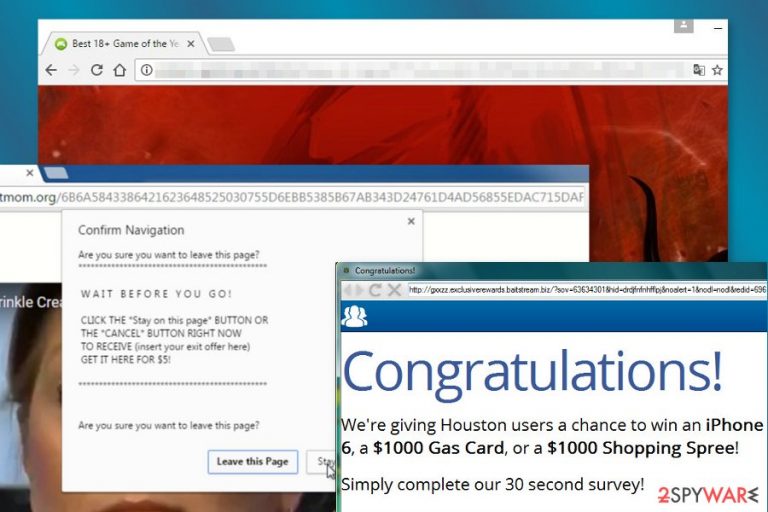
Media-serving.com is a deceptive website that is designed to redirect users to numerous suspicious sites. Users are usually redirected to this site by adware that might be installed silently with freeware or shareware. Once they end up there, the website might redirect them to gaming, adult-themed, survey,[1] scam, or other suspicious sites.
When adware gets inside the computer, it starts interfering with browsing sessions. The PUP might open a new browser’s tab or windows, redirect to third-party sites after clicking on links, videos, or other content. However, it’s not the only activity caused by the virus.
| Name | Media-serving.com |
|---|---|
| Type | Adware, PUP |
| Issues | It displays unwanted content on the screen and triggers redirects |
| Distribution | Freeware installations |
| Removal | Run anti-malware tool to get rid of the PUP completely |
| Repair | Getting a FortectIntego can find and even fi issues with the system and virus damage |
On the affected device it might also alter the browser’s settings in order to display ads. Numerous pop-ups, in-text ads, or banners might offer discount coupons, security software, or warn about outdated software. However, Media-serving.com redirect tendencies are concerning and might your personal privacy and computer at risk.
Adware might deliver ads and redirect to websites that might be malicious or misleading. Within one click you might end up on a site that was created for spreading malware. What is more, adware is known for redirecting users to technical support scam websites or suspicious software download sites.
Undoubtedly, you should not click Media-serving.com ads. What is more, you should not tolerate redirects as well. These activities might end up with infiltration of Trojan[2] or spyware. However, the adware itself might be capable of monitoring your online activities. Data tracking helps to learn more about user’s preferences and display individualized commercial content.
Certainly, the proper potentially unwanted program removal helps to avoid cyber threats. What is more, it’s necessary for getting back to normal browsing sessions. Once you terminate it from the PC, you will be able to browse the web without annoying distractions.
The best way to remove Media-serving.com from the computer is to employ a professional anti-malware/anti-spyware program, for instance, SpyHunter 5Combo Cleaner or Malwarebytes. This updates software can identify adware and delete it together with its components.

Developers of the PUP relies on the bundling technique
This potentially unwanted program (PUP) spreads bundled with various free programs that you can download from torrents or file-sharing sites. Freeware and shareware usually include additional components that are hidden under Quick/Recommended settings.
Unfortunately, these settings are popular among computer users not only in America. The same problem exists in Germany,[3] France, and other European countries. Thus, we want to remind you that you should not rely on the quick installation option. These settings do not allow “unpacking” software packages and seeing what is inside.
Therefore, the hijack may have occurred during the recent incorrect installation of a program. You could have avoided this problem if you have opted for Advanced/Custom mode. These settings allow monitoring the process and rejecting the installation of the additional third-party software.
Uninstall Media-serving.com virus and get rid of redirect problems
Installation of the ad-blocking application won’t help to fight ads and redirects. However, a professional security program might be helpful. One of the ways to remove the virus relies on system scans with security software. Thus, if this method seems right for you, install your preferred software and get rid of the adware.
Although automatic removal is the quickest elimination option, you can also wipe out PUP manually. This method requires investigating the system and locating adware-related components. They might be installed on the computer or each of the web browsers. However, our prepared Media-serving.com removal guidelines will help you delete the virus manually.
You may remove virus damage with a help of FortectIntego. SpyHunter 5Combo Cleaner and Malwarebytes are recommended to detect potentially unwanted programs and viruses with all their files and registry entries that are related to them.
Getting rid of Media-serving.com virus. Follow these steps
Uninstall from Windows
Instructions for Windows 10/8 machines:
- Enter Control Panel into Windows search box and hit Enter or click on the search result.
- Under Programs, select Uninstall a program.
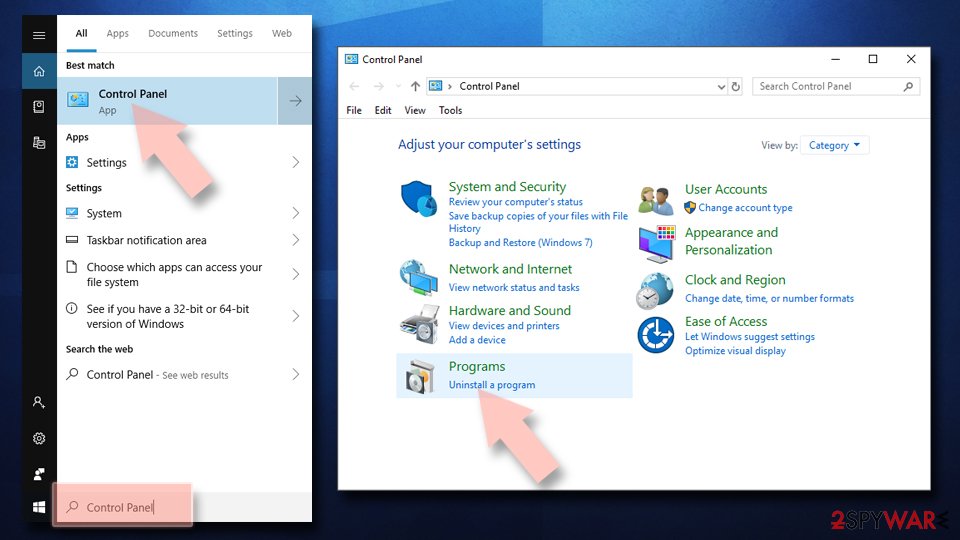
- From the list, find the entry of the suspicious program.
- Right-click on the application and select Uninstall.
- If User Account Control shows up, click Yes.
- Wait till uninstallation process is complete and click OK.
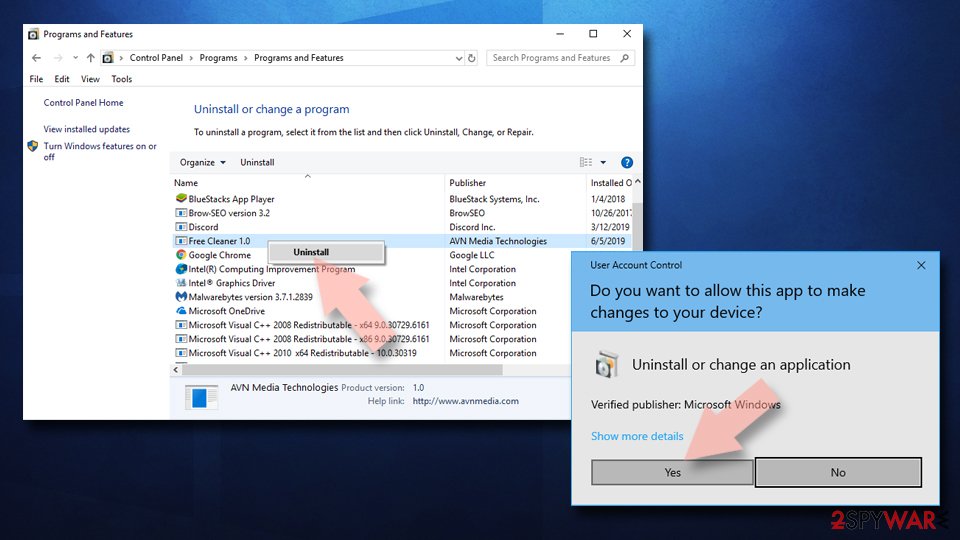
If you are Windows 7/XP user, proceed with the following instructions:
- Click on Windows Start > Control Panel located on the right pane (if you are Windows XP user, click on Add/Remove Programs).
- In Control Panel, select Programs > Uninstall a program.

- Pick the unwanted application by clicking on it once.
- At the top, click Uninstall/Change.
- In the confirmation prompt, pick Yes.
- Click OK once the removal process is finished.
Delete from macOS
Remove items from Applications folder:
- From the menu bar, select Go > Applications.
- In the Applications folder, look for all related entries.
- Click on the app and drag it to Trash (or right-click and pick Move to Trash)
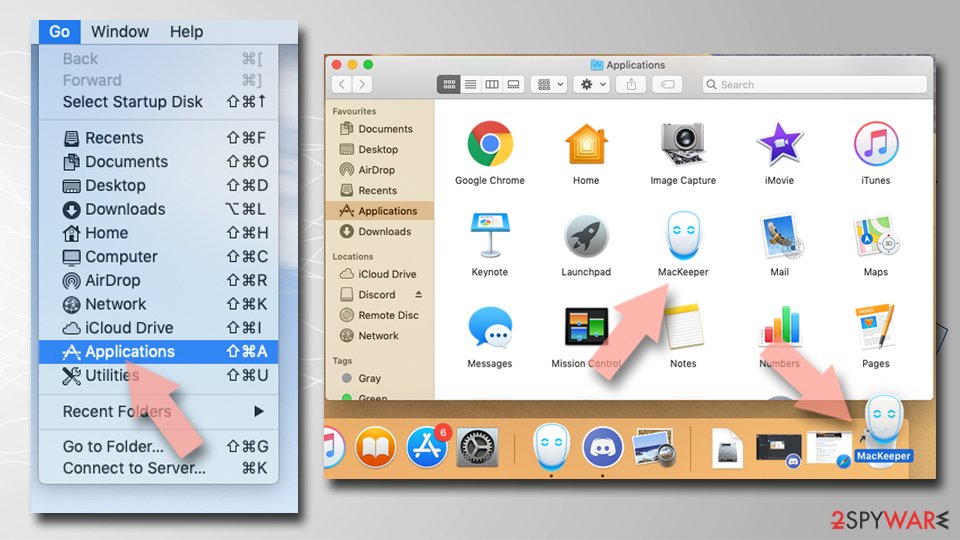
To fully remove an unwanted app, you need to access Application Support, LaunchAgents, and LaunchDaemons folders and delete relevant files:
- Select Go > Go to Folder.
- Enter /Library/Application Support and click Go or press Enter.
- In the Application Support folder, look for any dubious entries and then delete them.
- Now enter /Library/LaunchAgents and /Library/LaunchDaemons folders the same way and terminate all the related .plist files.
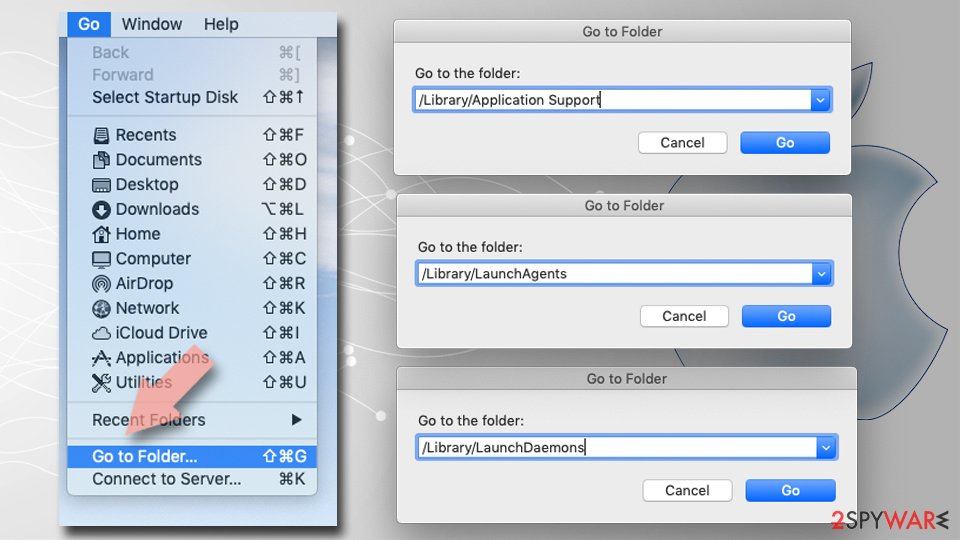
Remove from Microsoft Edge
Delete unwanted extensions from MS Edge:
- Select Menu (three horizontal dots at the top-right of the browser window) and pick Extensions.
- From the list, pick the extension and click on the Gear icon.
- Click on Uninstall at the bottom.
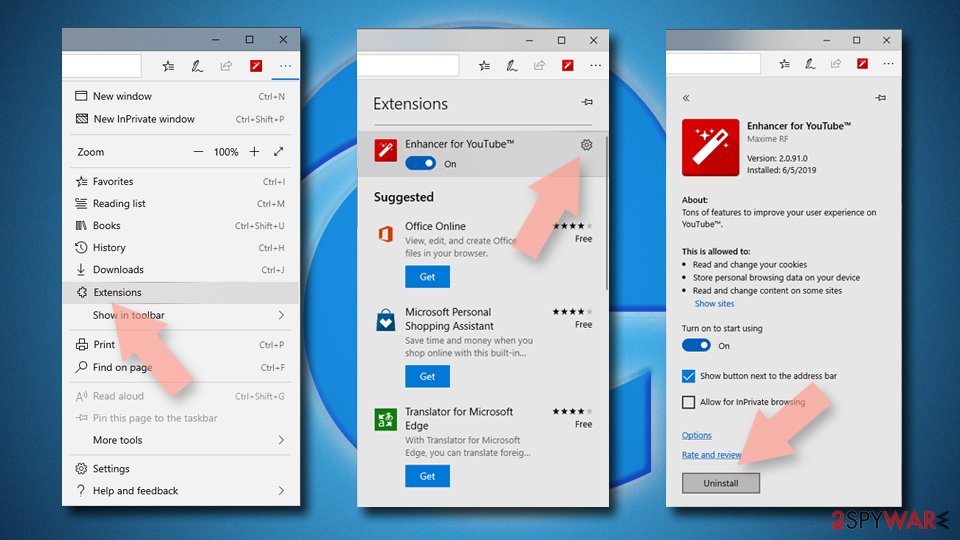
Clear cookies and other browser data:
- Click on the Menu (three horizontal dots at the top-right of the browser window) and select Privacy & security.
- Under Clear browsing data, pick Choose what to clear.
- Select everything (apart from passwords, although you might want to include Media licenses as well, if applicable) and click on Clear.
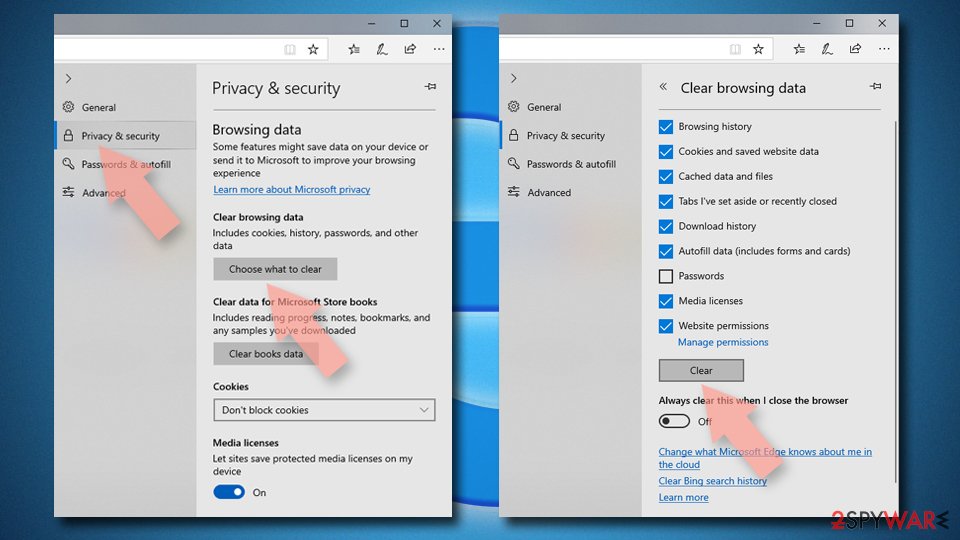
Restore new tab and homepage settings:
- Click the menu icon and choose Settings.
- Then find On startup section.
- Click Disable if you found any suspicious domain.
Reset MS Edge if the above steps did not work:
- Press on Ctrl + Shift + Esc to open Task Manager.
- Click on More details arrow at the bottom of the window.
- Select Details tab.
- Now scroll down and locate every entry with Microsoft Edge name in it. Right-click on each of them and select End Task to stop MS Edge from running.
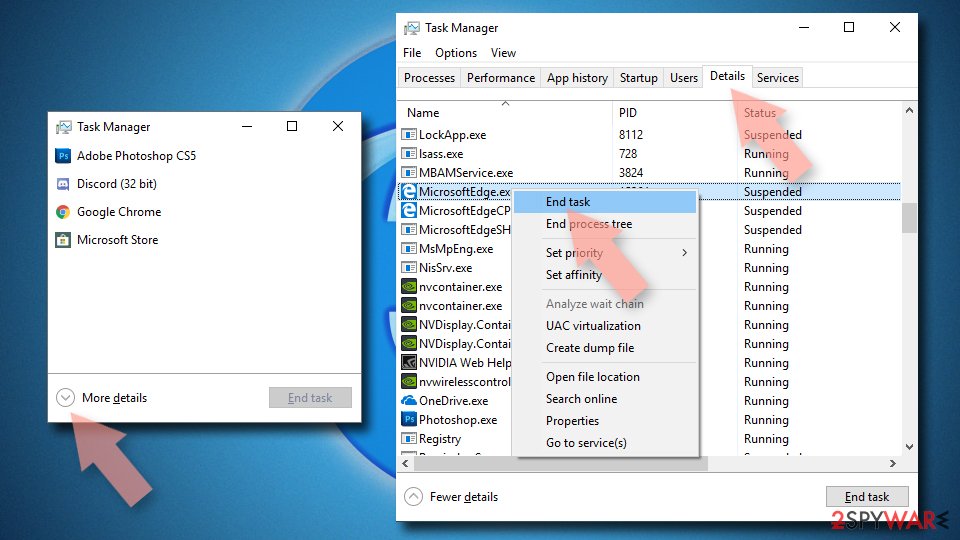
If this solution failed to help you, you need to use an advanced Edge reset method. Note that you need to backup your data before proceeding.
- Find the following folder on your computer: C:\\Users\\%username%\\AppData\\Local\\Packages\\Microsoft.MicrosoftEdge_8wekyb3d8bbwe.
- Press Ctrl + A on your keyboard to select all folders.
- Right-click on them and pick Delete
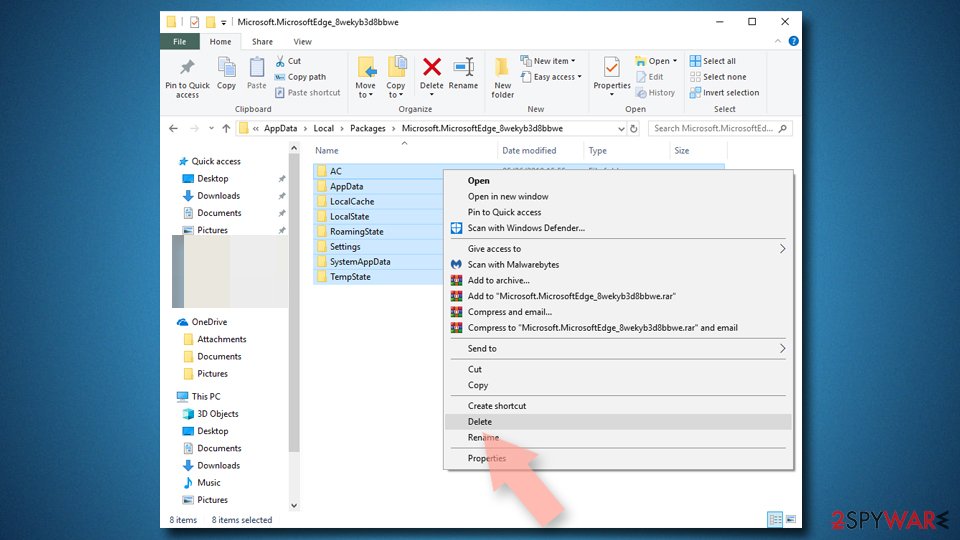
- Now right-click on the Start button and pick Windows PowerShell (Admin).
- When the new window opens, copy and paste the following command, and then press Enter:
Get-AppXPackage -AllUsers -Name Microsoft.MicrosoftEdge | Foreach {Add-AppxPackage -DisableDevelopmentMode -Register “$($_.InstallLocation)\\AppXManifest.xml” -Verbose
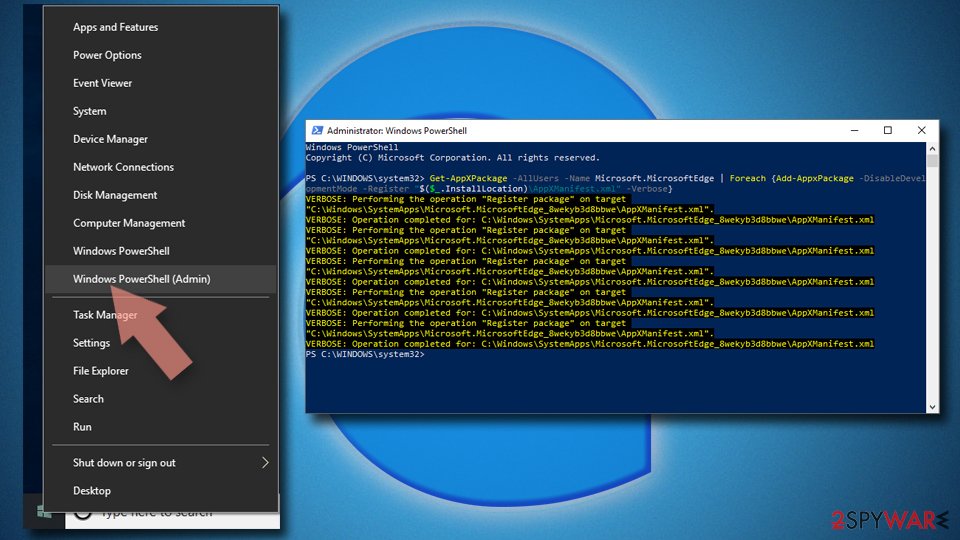
Instructions for Chromium-based Edge
Delete extensions from MS Edge (Chromium):
- Open Edge and click select Settings > Extensions.
- Delete unwanted extensions by clicking Remove.
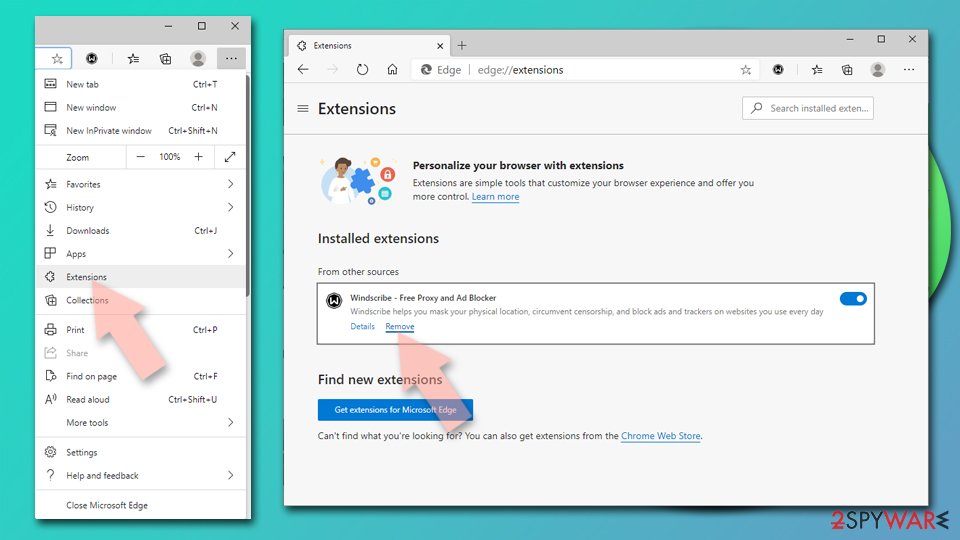
Clear cache and site data:
- Click on Menu and go to Settings.
- Select Privacy, search and services.
- Under Clear browsing data, pick Choose what to clear.
- Under Time range, pick All time.
- Select Clear now.
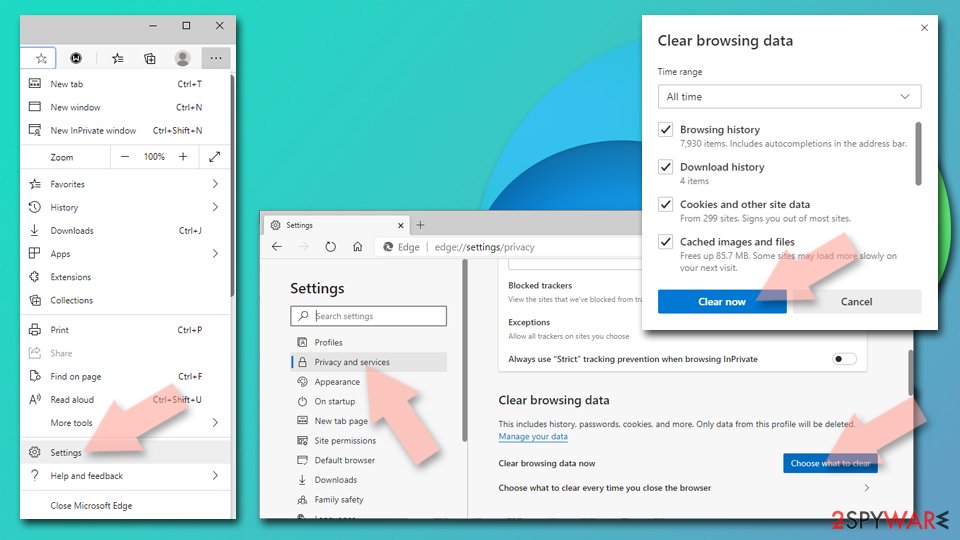
Reset Chromium-based MS Edge:
- Click on Menu and select Settings.
- On the left side, pick Reset settings.
- Select Restore settings to their default values.
- Confirm with Reset.
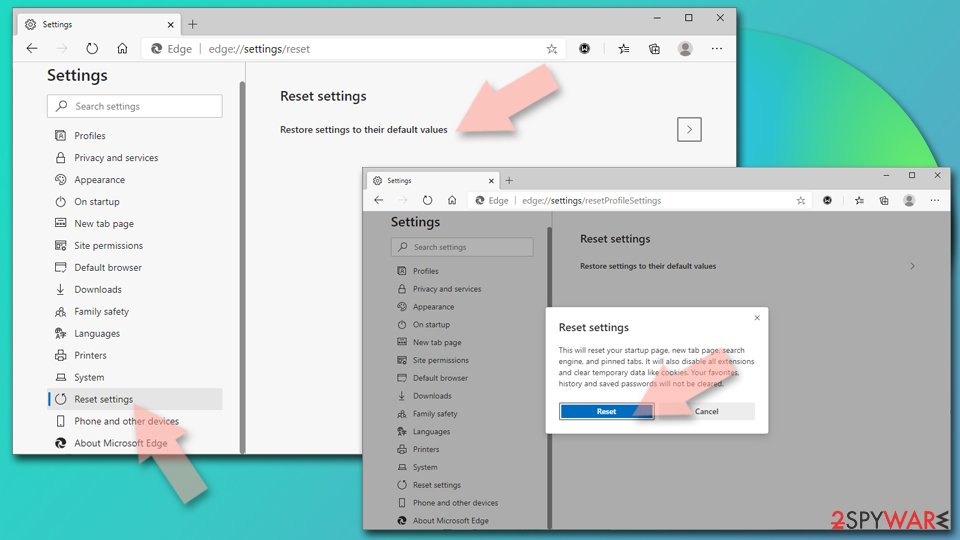
Remove from Mozilla Firefox (FF)
Remove dangerous extensions:
- Open Mozilla Firefox browser and click on the Menu (three horizontal lines at the top-right of the window).
- Select Add-ons.
- In here, select unwanted plugin and click Remove.
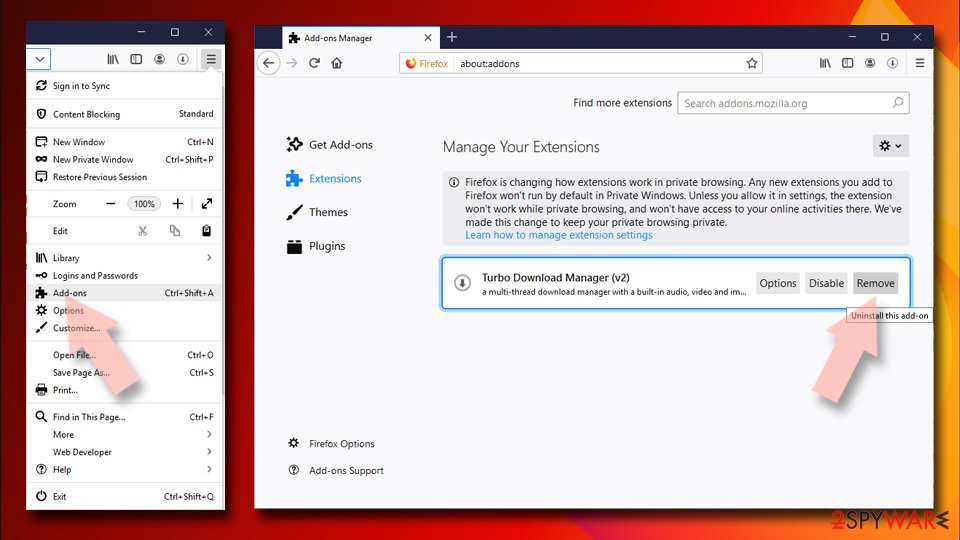
Reset the homepage:
- Click three horizontal lines at the top right corner to open the menu.
- Choose Options.
- Under Home options, enter your preferred site that will open every time you newly open the Mozilla Firefox.
Clear cookies and site data:
- Click Menu and pick Settings.
- Go to Privacy & Security section.
- Scroll down to locate Cookies and Site Data.
- Click on Clear Data…
- Select Cookies and Site Data, as well as Cached Web Content and press Clear.
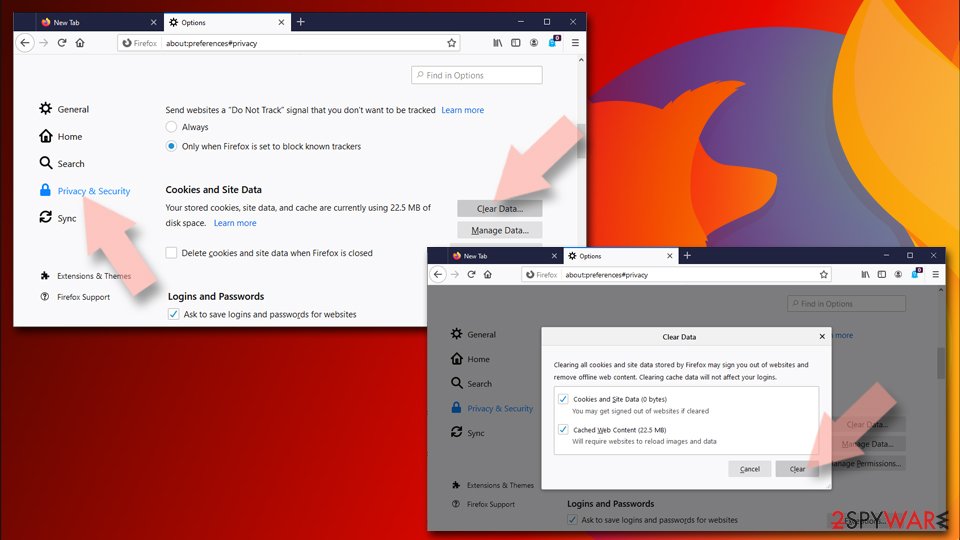
Reset Mozilla Firefox
If clearing the browser as explained above did not help, reset Mozilla Firefox:
- Open Mozilla Firefox browser and click the Menu.
- Go to Help and then choose Troubleshooting Information.
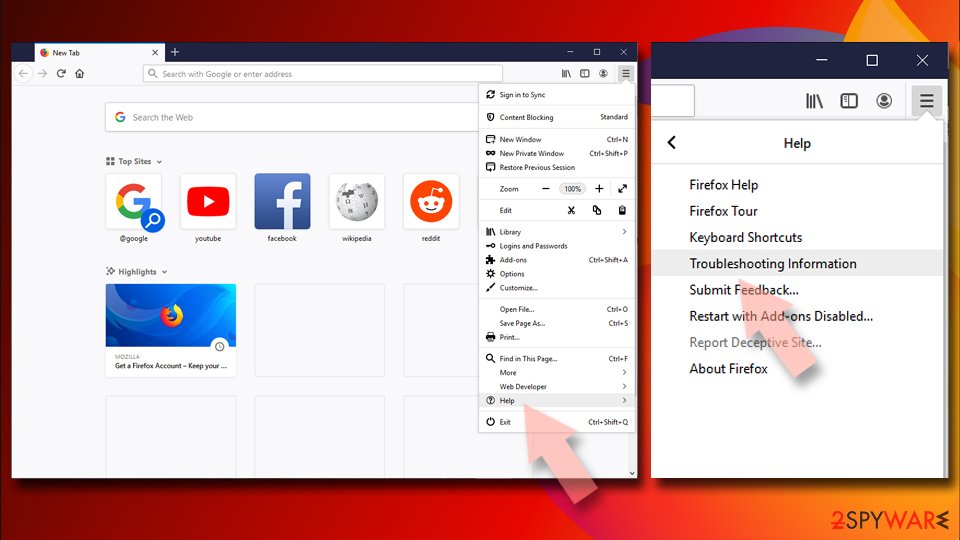
- Under Give Firefox a tune up section, click on Refresh Firefox…
- Once the pop-up shows up, confirm the action by pressing on Refresh Firefox.
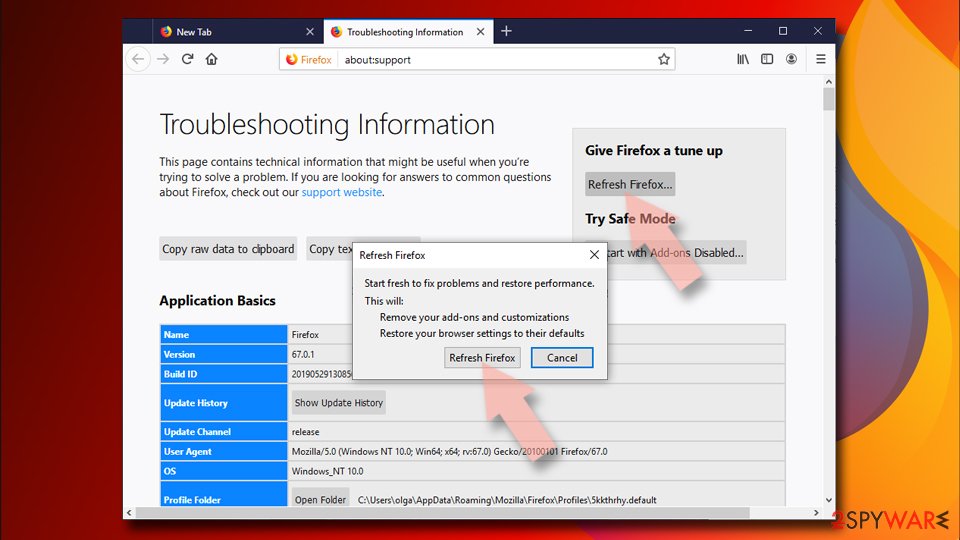
Remove from Google Chrome
Delete malicious extensions from Google Chrome:
- Open Google Chrome, click on the Menu (three vertical dots at the top-right corner) and select More tools > Extensions.
- In the newly opened window, you will see all the installed extensions. Uninstall all the suspicious plugins that might be related to the unwanted program by clicking Remove.
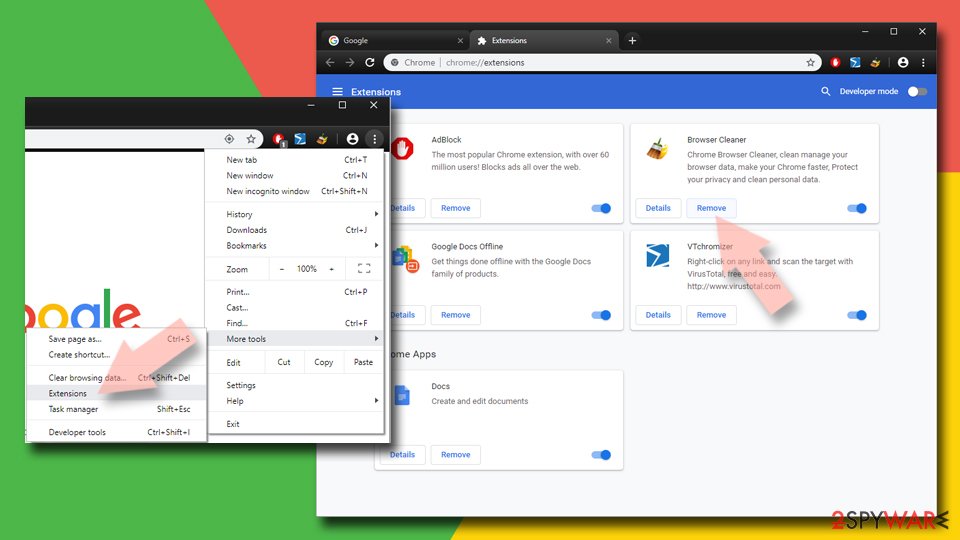
Clear cache and web data from Chrome:
- Click on Menu and pick Settings.
- Under Privacy and security, select Clear browsing data.
- Select Browsing history, Cookies and other site data, as well as Cached images and files.
- Click Clear data.
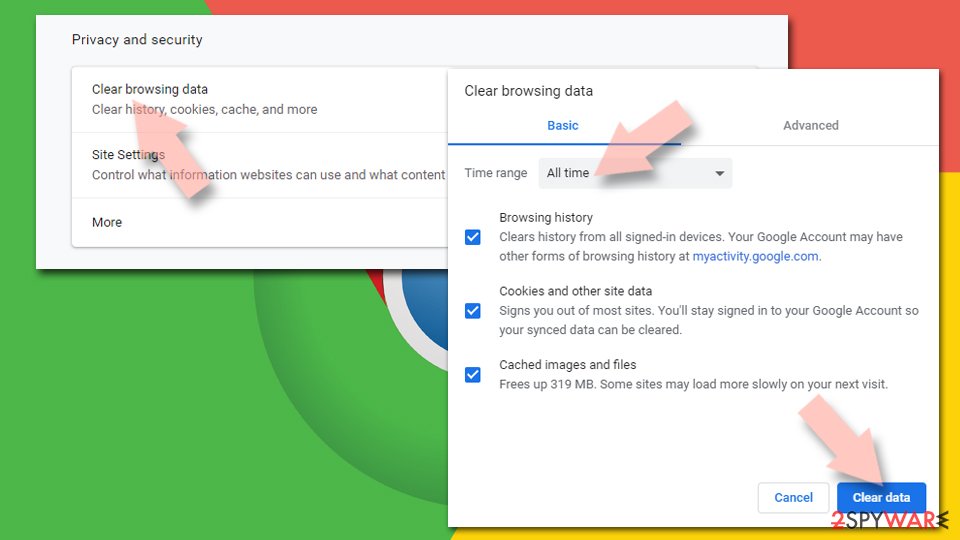
Change your homepage:
- Click menu and choose Settings.
- Look for a suspicious site in the On startup section.
- Click on Open a specific or set of pages and click on three dots to find the Remove option.
Reset Google Chrome:
If the previous methods did not help you, reset Google Chrome to eliminate all the unwanted components:
- Click on Menu and select Settings.
- In the Settings, scroll down and click Advanced.
- Scroll down and locate Reset and clean up section.
- Now click Restore settings to their original defaults.
- Confirm with Reset settings.
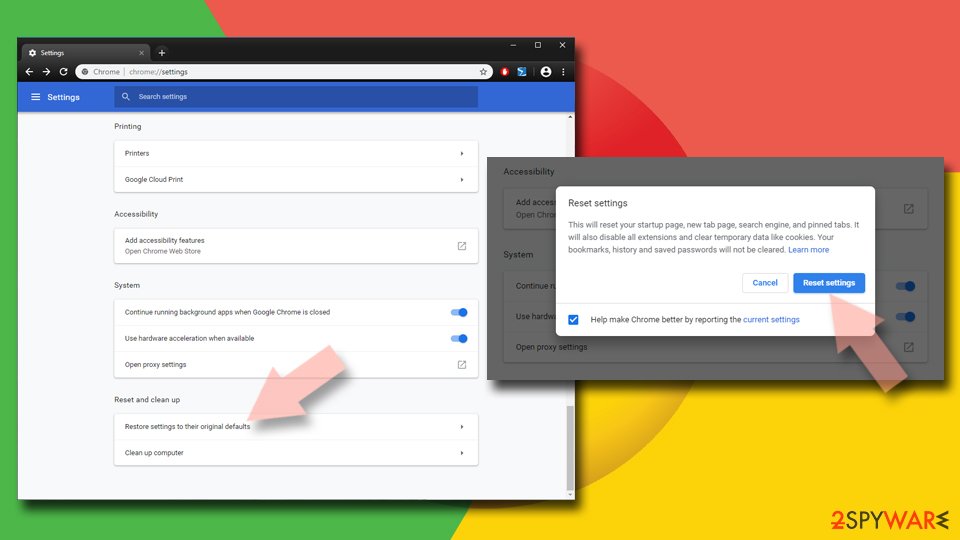
Delete from Safari
Remove unwanted extensions from Safari:
- Click Safari > Preferences…
- In the new window, pick Extensions.
- Select the unwanted extension and select Uninstall.
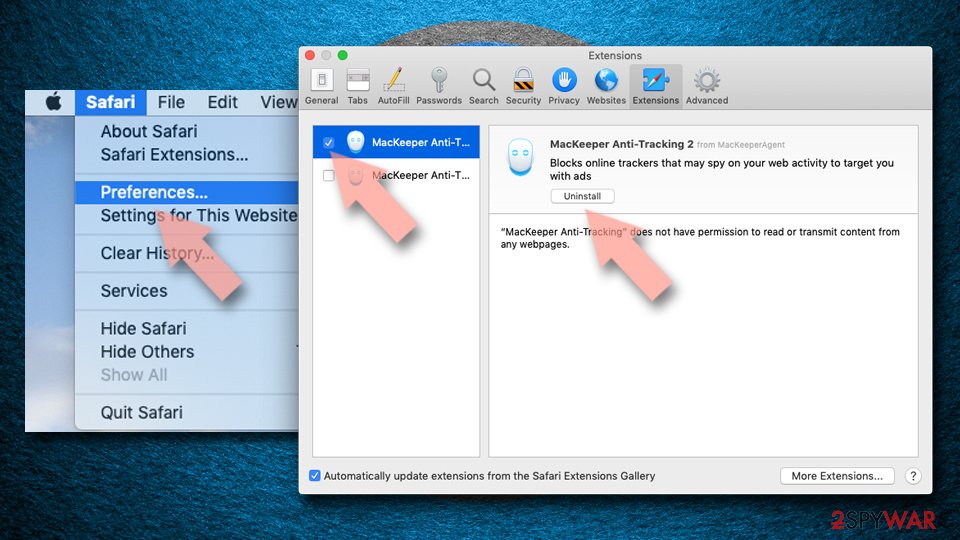
Clear cookies and other website data from Safari:
- Click Safari > Clear History…
- From the drop-down menu under Clear, pick all history.
- Confirm with Clear History.
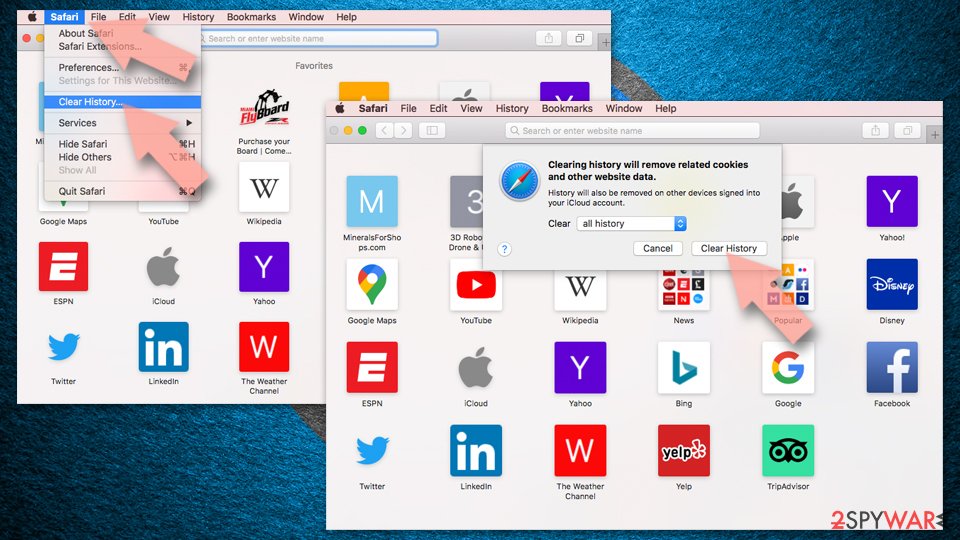
Reset Safari if the above-mentioned steps did not help you:
- Click Safari > Preferences…
- Go to Advanced tab.
- Tick the Show Develop menu in menu bar.
- From the menu bar, click Develop, and then select Empty Caches.
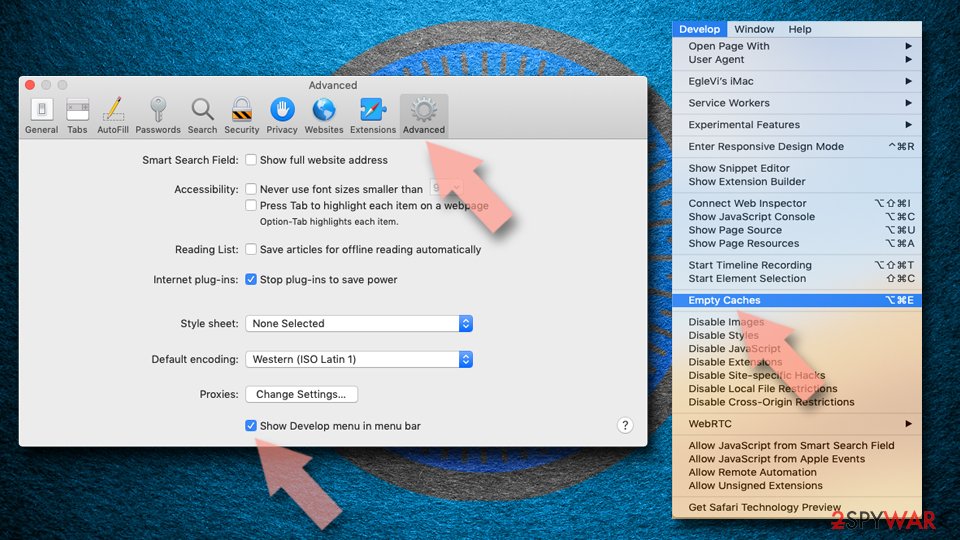
After uninstalling this potentially unwanted program (PUP) and fixing each of your web browsers, we recommend you to scan your PC system with a reputable anti-spyware. This will help you to get rid of Media-serving.com registry traces and will also identify related parasites or possible malware infections on your computer. For that you can use our top-rated malware remover: FortectIntego, SpyHunter 5Combo Cleaner or Malwarebytes.
How to prevent from getting adware
Access your website securely from any location
When you work on the domain, site, blog, or different project that requires constant management, content creation, or coding, you may need to connect to the server and content management service more often. The best solution for creating a tighter network could be a dedicated/fixed IP address.
If you make your IP address static and set to your device, you can connect to the CMS from any location and do not create any additional issues for the server or network manager that needs to monitor connections and activities. VPN software providers like Private Internet Access can help you with such settings and offer the option to control the online reputation and manage projects easily from any part of the world.
Recover files after data-affecting malware attacks
While much of the data can be accidentally deleted due to various reasons, malware is one of the main culprits that can cause loss of pictures, documents, videos, and other important files. More serious malware infections lead to significant data loss when your documents, system files, and images get encrypted. In particular, ransomware is is a type of malware that focuses on such functions, so your files become useless without an ability to access them.
Even though there is little to no possibility to recover after file-locking threats, some applications have features for data recovery in the system. In some cases, Data Recovery Pro can also help to recover at least some portion of your data after data-locking virus infection or general cyber infection.
- ^ 15 Ways You Can Avoid and Report Online Surveys Scams. Survey Satrap. Real Paid Survey Reviews.
- ^ Linas Kiguolis. How to remove trojans. NoVirus. Recent cyber security news and malware removal instructions.
- ^ DieViren. DieViren. German site about computer viruses.
